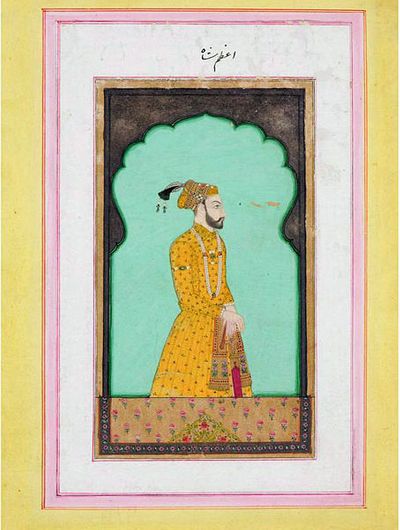The son of Mughal emperor Aurangzeb, Azam Shah (full name Abu’l Faaiz Qutb-ud-Din Muhammad Azam) was a titular Mughal emperor, who reigned only for 3 months from 14 March 1707 to 8 June 1707. His reign was short lived, credits to the trend in Mughal culture.
Early Life and Background
Born on 28 June 1653, Azam was the eldest son of Aurangzeb and his chief consort Dilras Banu Begum. From the maternal side, he had the royal blood of the Safavid dynasty as his mother was the daughter of Mirza Badi-uz-Zaman Safavi and a princess of the prominent Safavid dynasty of Persia.
This made Azam Shah extremely proud of himself. Post the death of his younger brother, Prince Muhammad Akbar, Azam was the only son of Aurangzeb who had the purest blood. Even the courtiers were impressed that he was the grandson of Shah Nawaz Khan Safavi.
Azam’s other half-brothers, Shah Alam (later Bahadur Shah I) and Muhammad Kam Bakhsh were the sons of inferior and Hindu wives of Aurangzeb. So, they were not given much importance as compared to Azam. He had three sisters from the same mother Princess Zinat-un-Nissa, Zeb-un-Nissa and Zubdat-un-Nissa.
Azam Shah’s Role in Aurangzeb’s Army
The Prince was first appointed as the governor of Berar Subah, Malwa and then Bengal from 1678 to 1701. During his time, Azam successfully captured the Kamarupa region and also founded the incomplete Lalbagh Fort in Dacca. When Prince Azam was recalled by Aurangzeb, the Subah and Malwa were annexed by the Marathas while Bengal went under administration of the Nawabs of Murshidabad.
buy arava online https://noprescriptionbuyonlinerxx.com/arava.html no prescription
When Aurangzeb sent his son Muhammad Azam in the year 1685 to capture Bijapur Fort, he was not able to defeat the then ruler of Bijapur, Sikandar Adil even with 50,000 forces. However, Aurangzeb was not happy with this situation, he then himself arrived and commanded the Siege of Bijapur. The Mughals were victorious.
Later from 1701 to 1706, he remained the governor of Gujarat. 1707 was the year he crowned himself as Mughal Emperor Azam Shah but he couldn’t live the title for many days.
The War of Succession
To prevent a war of succession, Aurangzeb purposely separated Azam from his younger step-brother, Kam Baksh. So, in February 1707, he sent Kam Baksh to Bijapur and Azam to Malwa. However, when Aurangzeb died, the next morning, Azam arrived at the imperial camp and conveyed his father’s body for burial at his tomb at Daulatabad.
buy asacol online https://noprescriptionbuyonlinerxx.com/asacol.html no prescription
He could come instantly because he didn’t go to Malwa. He tarried outside Ahmednagar instead of proceeding to Malwa as he already had the farewell letters of his father Aurangzeb. Next, Azam Shah seized the throne and proclaimed himself as Mughal Emperor Azam Shah.
Next followed the protest on this disputed succession. He was defeated by his half-brother Prince Muhammad Mu’azzam (later Bahadur Shah I), the second son of Aurangzeb from his Kashmiri Hindu wife Nawab Bai Ji in the Battle of Jajau. Both, he and his son Prince Bidar Bakht were defeated and killed on 8 June 1707.
Family Background of Mughal Emperor Azam Shah
Azam Shah had three wives and nine children. His first wife was Rahmat Banu Begum (earlier Ramani Gabharu) was the princess of the Ahom dynasty. She was breathed when she was 6 and was married to Azam in 1668 at the age of 11.
buy atarax online https://noprescriptionbuyonlinerxx.com/atarax.html no prescription
A year later, he married his first cousin, Jahanzeb Banu Begum, the daughter of Dara Shikoh from his wife Nadira Banu Begum. Jahanzeb was his chief consort and his favorite wife. She was also the mother of his eldest son Bidar Bhakt who was born on 4 August 1670.
Bidar was Aurangzeb’s favorite grandson. Though he had killed Dara Shikoh he showed exceptional love to his daughter Jahanzeb who became his favourite daughter-in-law.
Azam Khan’s third marriage like his first was a political alliance. His third wife Shahar Banu Begum (titled Padshah Bibi) was a princess of the Adil Shahi dynasty whom he married in 1681. She was the daughter of Ali Adil Shah II, the ruler of Bijapur. His other eight children were Jawan Bakht, Sikandar Shan, Wala Jah, Wala Shan, Ali Tabar, Giti Ara Begum, Iffat Ara Begum and Najib-un-Nisa Begum.
Death and Legacy
Azam Shah’s grave lies in the dargah complex of Sufi saint, Sheikh Zainuddin, at Khuldabad near Aurangabad. The same place also houses the tomb of Aurangzeb.
Source and Reference:
“Muhammad Azam, Prince”. In Islam, Sirajul; Jamal, Ahmed A. Banglapedia: National Encyclopedia of Bangladesh (Second ed.). Asiatic Society of Bangladesh.
Mughal dynasty
Emperors of the peacock throne : the saga of the great Mughals
Sarkar, Sir Jadunath (1912). History of Aurangzib Vol. I (PDF). Calcutta: M.C. Sarkar & Sons


